Artificial Intelligence Approaches for EEG Signal Acquisition and Processing in Lower-Limb Motor Imagery: A Systematic Review
Abstract
Highlights
- This review highlights that advanced machine learning algorithms and multimodal fusion strategies have improved the accuracy and robustness of lower-limb motor imagery classification, pointing to a trend toward portable, low-power BCI devices optimized for fewer EEG channels.
- These developments pave the way for clinically viable BCIs that are accessible, adaptable, and suitable for real-world neurorehabilitation contexts.
Abstract
1. Introduction
2. Methods
2.1. Eligibility Criteria
2.2. Search Methodology and Scope
2.3. Study Identification and Screening
2.4. Data Extraction and Items
3. Results
3.1. General Characteristics of the Included Studies
3.2. Bibliometric Analysis
3.3. Conceptual Foundations of BCI and EEG Systems
3.4. BCI and EEG Signal Acquisition and Processing
3.5. Artificial Intelligence-Based Signal Processing
3.6. Motion Imagery (MI) Rehabilitation Applications in Lower Limbs
4. Discussion
4.1. Review Discussion and Perspectives
4.2. Implications for Future Research and Clinical Practice
4.3. Limitations of the Evidence Base and Review Process
5. Conclusions
Author Contributions
Funding
Institutional Review Board Statement
Informed Consent Statement
Data Availability Statement
Acknowledgments
Conflicts of Interest
Abbreviations
| AI | Artificial intelligence |
| (A)NN | (Artificial) neural network |
| ANOVA | Analysis of Variance |
| BCI | Brain–computer interface |
| CNN | Convolutional neural network |
| (D)CSP | (Disperse) Common Spatial Pattern |
| CTR | Continuous-trajectory reconstruction |
| DCA | Discriminant Correlation Analysis |
| DL | Deep learning |
| DSP | Digital Signal Processor |
| DWT | Discrete Wavelet Transform |
| EEG | Electroencephalography |
| EEG-BCI | Electroencephalogram-based brain–computer interface |
| (E)EMD | (Ensemble) empirical mode decomposition |
| EMG | Electromyography |
| ERD | Event-related desynchronization |
| ERS | Event-related synchronization |
| FBCSP | Filter Bank Common Spatial Pattern |
| FC | Functional connectivity |
| FFT | Fast Fourier Transform |
| FMRI | Functional Magnetic Resonance Imaging |
| FNIRS | Functional Near-Infrared Spectroscopy |
| HMI | Human–machine interface |
| HOS | Higher-Order Statistics |
| HRI | Human–robot interaction |
| IEEE | Institute of Electrical and Electronics Engineers |
| KNN | K-Nearest Neighbors |
| LDA | Linear Discriminant Analysis |
| LSTM | Long short-term memory |
| MCU | Microcontroller unit |
| MDF | Multidomain feature |
| MEG | Magnetoencephalography |
| MI | Motor imagery |
| MI-BCI | Motor imagery brain–computer interface |
| ML | Machine learning |
| MLP | Multilayer perceptron |
| MOABB | Mother of All BCI Benchmarks |
| MRCP | Magnetic Resonance Cholangiopancreatography |
| OCS | Optimal channel set |
| PCC | Pearson’s correlation coefficient |
| PLV | Phase-locking value |
| PRISMA | Preferred Reporting Items for Systematic Reviews and Meta-Analyses |
| PSO | Particle swarm optimization |
| RF | Random Forest |
| RFE | Recursive feature elimination |
| RLLFC | Riemannian Local Linear Feature Construction |
| RNN | Recurrent neural network |
| RWOS-ELM | Regularized weighted online sequential extreme learning machine |
| SMLR | Sparse multinomial logistic regression |
| SMLR-SVM | Sparse multinomial logistic regression Support Vector Machine |
| SNR | Signal-to-noise ratio |
| SVM | Support Vector Machine |
| TBI | Traumatic brain injury |
| TCS | Traditional channel set |
| ViT | Vision Transformer |
| VR | Virtual reality |
| WPD | Wavelet packet decomposition |
| WPT | Wavelet packet transform |
| WT | Wavelet transform |
References
- Scherer, R.; Vidaurre, C. Motor imagery based brain–computer interfaces. In Smart Wheelchairs and Brain-Computer Interfaces: Mobile Assistive Technologies; Academic Press: Cambridge, MA, USA, 2018; pp. 171–195. [Google Scholar] [CrossRef]
- Nanbancha, A.; Mawhinney, C.; Sinsurin, K. The effect of motor imagery and action observation in the rehabilitation of lower limb injuries: A scoping review. Clin. Rehabil. 2023, 37, 145–161. [Google Scholar] [CrossRef]
- Tariq, M.; Trivalio, P.M.; Simic, M. Motor imagery based EEG features visualization for BCI applications. Procedia Computer Science. 2018, 126, 1936–1944. [Google Scholar] [CrossRef]
- Decety, J. The neurophysiological basis of motor imagery. Behav. Brain Res. 1996, 77, 45–52. [Google Scholar] [CrossRef] [PubMed]
- Mohamed, E.A.; Yusoff, M.Z.; Malik, A.S.; Bahloul, M.R.; Adam, D.M.; Adam, I.K. Comparison of EEG signal decomposition methods in classification of motor-imagery BCI. Multimed. Tools Appl. 2018, 77, 21305–21327. [Google Scholar] [CrossRef]
- Aggarwal, S.; Chugh, N. Signal processing techniques for motor imagery brain computer interface: A review. Array 2019, 1–2, 100003. [Google Scholar] [CrossRef]
- Milne-Ives, M.; Duun-Henriksen, J.; Blaabjerg, L.; Mclean, B.; Shankar, R.; Meinert, E. At home EEG monitoring technologies for people with epilepsy and intellectual disabilities: A scoping review. Seizure 2023, 110, 11–20. [Google Scholar] [CrossRef]
- Hampel, U.; Babout, L.; Banasiak, R.; Schleicher, E.; Soleimani, M.; Wondrak, T.; Vauhkonen, M.; Lähivaara, T.; Tan, C.; Hoyle, B.; et al. A Review on Fast Tomographic Imaging Techniques and Their Potential Application in Industrial Process Control. Sensors 2022, 22, 2309. [Google Scholar] [CrossRef]
- Lotze, M.; Cohen, L.G. Volition and imagery in neurorehabilitation. Cogn. Behav. Neurol. 2006, 19, 135–140. [Google Scholar] [CrossRef]
- Saibene, A.; Caglioni, M.; Corchs, S.; Gasparini, F. EEG-Based BCIs on Motor Imagery Paradigm Using Wearable Technologies: A Systematic Review. Sensors 2023, 23, 2798. [Google Scholar] [CrossRef]
- Suica, Z.; Platteau-Waldmeier, P.; Koppel, S.; Schmidt-Trucksaess, A.; Ettlin, T.; Schuster-Amft, C. Motor imagery ability assessments in four disciplines: Protocol for a systematic review. BMJ Open 2018, 8, e023439. [Google Scholar] [CrossRef]
- Glover, G.H. Overview of Functional Magnetic Resonance Imaging. Neurosurg. Clin. N. Am. 2011, 22, 133–139. [Google Scholar] [CrossRef]
- Gomez, J.B.; González, D.S.; Montoya, O.M.; Antelís, J.M. Análisis y clasificación de señales electroencefalográficas para el control de una órtesis robótica de mano con una interfaz cerebro computador basada en el paradigma de imaginación motora. Res. Comput. Sci. 2023, 152, 217. [Google Scholar]
- Page, M.J.; McKenzie, J.E.; Bossuyt, P.M.; Boutron, I.; Hoffmann, T.C.; Mulrow, C.D.; Shamseer, L.; Tetzlaff, J.M.; Akl, E.A.; Brennan, S.E.; et al. The PRISMA 2020 statement: An updated guideline for reporting systematic reviews. J. Clin. Epidemiol. 2021, 134, 178–189. [Google Scholar] [CrossRef] [PubMed]
- Mishra, V.; Mishra, M.P. PRISMA for review of management literature—Method, merits, and limitations—An academic review. Rev. Manag. Lit. 2023, 2, 125–136. [Google Scholar] [CrossRef]
- Maiseli, B.; Abdalla, A.T.; Massawe, L.V.; Mbise, M.; Mkocha, K.; Nassor, N.A.; Ismail, M.; Michael, J.; Kimambo, S. Brain–computer interface: Trend, challenges, and threats. Brain Inform. 2023, 10, 20. [Google Scholar] [CrossRef]
- de Melo, G.C.; Castellano, G.; Forner-Cordero, A. A procedure to minimize EEG variability for BCI applications. Biomed. Signal Process. Control 2024, 89, 105745. [Google Scholar] [CrossRef]
- Asanza, V.; Peláez, E.; Loayza, F.; Lorente-Leyva, L.L.; Peluffo-Ordóñez, D.H. Identification of Lower-Limb Motor Tasks via Brain–Computer Interfaces: A Topical Overview. Sensors 2022, 22, 2028. [Google Scholar] [CrossRef]
- Gorjan, D.; Gramann, K.; De Pauw, K.; Marusic, U. Removal of movement-induced EEG artifacts: Current state of the art and guidelines. J. Neural Eng. 2022, 19, 011004. [Google Scholar] [CrossRef]
- Kardam, V.S.; Taran, S.; Pandey, A. Motor Imagery Tasks Based Electroencephalogram Signals Classification Using Data-Driven Features. Neurosci. Inform. 2023, 3, 100128. [Google Scholar] [CrossRef]
- Mercado, L.; Alvarado, L.; Quiroz-Compean, G.; Romo-Vazquez, R.; Vélez-Pérez, H.; Platas-Garza, M.; González-Garrido, A.A.; Gómez-Correa, J.; Morales, J.A.; Rodriguez-Liñan, A.; et al. Decoding the torque of lower limb joints from EEG recordings of pre-gait movements using a machine learning scheme. Neurocomputing 2021, 446, 118–129. [Google Scholar] [CrossRef]
- Blanco-Diaz, C.F.; Guerrero-Mendez, C.D.; de Andrade, R.M.; Badue, C.; De Souza, A.F.; Delisle-Rodriguez, D.; Bastos-Filho, T. Decoding lower-limb kinematic parameters during pedaling tasks using deep learning approaches and EEG. Med. Biol. Eng. Comput. 2024, 62, 3763–3779. [Google Scholar] [CrossRef] [PubMed]
- Gordleeva, S.Y.; Lobov, S.A.; Grigorev, N.A.; Savosenkov, A.O.; Shamshin, M.O.; Lukoyanov, M.V.; Khoruzhko, M.A.; Kazantsev, V.B. Real-Time EEG–EMG human–machine interface-based control system for a lower-limb exoskeleton. IEEE Access 2020, 8, 84070–84081. [Google Scholar] [CrossRef]
- Al-Quraishi, M.S.; Elamvazuthi, I.; Tang, T.B.; Al-Qurishi, M.; Parasuraman, S.; Borboni, A. Multimodal Fusion Approach Based on EEG and EMG Signals for Lower Limb Movement Recognition. IEEE Sens. J. 2021, 21, 27640–27650. [Google Scholar] [CrossRef]
- Noor, N.S.E.M.; Ibrahim, H.; Lai, C.Q.; Abdullah, J.M. A Long Short-Term Memory Network Using Resting-State Electroencephalogram to Predict Outcomes Following Moderate Traumatic Brain Injury. Computers 2023, 12, 45. [Google Scholar] [CrossRef]
- Peng, X.; Liu, J.; Huang, Y.; Mao, Y.; Li, D. Classification of lower limb motor imagery based on iterative EEG source localization and feature fusion. Neural Comput. Appl. 2022, 35, 13711–13724. [Google Scholar] [CrossRef]
- Pawan; Dhiman, R. Electroencephalogram channel selection based on pearson correlation coefficient for motor imagery-brain-computer interface. Meas. Sens. 2022, 25, 100616. [Google Scholar] [CrossRef]
- Gu, L.; Yu, Z.; Ma, T.; Wang, H.; Li, Z.; Fan, H. EEG-based Classification of Lower Limb Motor Imagery with Brain Network Analysis. Neuroscience 2020, 436, 93–109. [Google Scholar] [CrossRef]
- Ortiz, M.; de la Ossa, L.; Juan, J.; Iáñez, E.; Torricelli, D.; Tornero, J.; Azorín, J.M. An EEG database for the cognitive assessment of motor imagery during walking with a lower-limb exoskeleton. Sci. Data 2023, 10, 343. [Google Scholar] [CrossRef]
- Fu, R.; Han, M.; Tian, Y.; Shi, P. Improvement motor imagery EEG classification based on sparse common spatial pattern and regularized discriminant analysis. J. Neurosci. Methods 2020, 343, 108833. [Google Scholar] [CrossRef]
- Mwata-Velu, T.; Rodríguez, A.N.; Mfuni-Tshimanga, Y.; Mavuela-Maniansa, R.; Castro, J.A.M.; Ruiz-Pinales, J.; Avina-Cervantes, J.G. EEG-BCI Features Discrimination between Executed and Imagined Movements Based on FastICA, Hjorth Parameters, and SVM. Mathematics 2023, 11, 4409. [Google Scholar] [CrossRef]
- Fu, Y.; Zhou, Z.; Gong, A.; Qian, Q.; Su, L.; Zhao, L.; Versaci, M. Decoding of Motor Coordination Imagery Involving the Lower Limbs by the EEG-Based Brain Network. Comput. Intell. Neurosci. 2021, 2021, 5565824. [Google Scholar] [CrossRef]
- Zhang, L.; Li, C.; Zhang, R.; Sun, Q. Online semi-supervised learning for motor imagery EEG classification. Comput. Biol. Med. 2023, 165, 107405. [Google Scholar] [CrossRef]
- Al-Quraishi, M.S.; Elamvazuthi, I.; Tang, T.B.; Al-Qurishi, M.S.; Adil, S.H.; Ebrahim, M.; Borboni, A. Decoding the User’s Movements Preparation From EEG Signals Using Vision Transformer Architecture. IEEE Access 2022, 10, 109446–109459. [Google Scholar] [CrossRef]
- Chen, X.; Teng, X.; Chen, H.; Pan, Y.; Geyer, P. Toward reliable signals decoding for electroencephalogram: A benchmark study to EEGNeX. Biomed. Signal Process. Control 2023, 87, 105475. [Google Scholar] [CrossRef]
- Wu, Z.; Tang, X.; Wu, J.; Huang, J.; Shen, J.; Hong, H. Portable deep-learning decoder for motor imaginary EEG signals based on a novel compact convolutional neural network incorporating spatial-attention mechanism. Med. Biol. Eng. Comput. 2023, 61, 2391–2404. [Google Scholar] [CrossRef] [PubMed]
- Hou, Y.; Tang, R.; Xie, X. A Decoding Method Using Riemannian Local Linear Feature Construction for a Lower-Limb Motor Imagery Brain–Computer Interface System. Electronics 2023, 12, 4697. [Google Scholar] [CrossRef]
- Thenmozhi, T.; Helen, R. Feature Selection Using Extreme Gradient Boosting Bayesian Optimization to upgrade the Classification Performance of Motor Imagery signals for BCI. J. Neurosci. Methods 2022, 366, 109425. [Google Scholar] [CrossRef]
- Li, L.-L.; Cao, G.-Z.; Zhang, Y.-P.; Cui, F. A Novel Lower Limb Motion Intention Recognition Model Using ConvNet with Prob-Sparse Attention. IEEE Sens. J. 2025, 25, 9056–9069. [Google Scholar] [CrossRef]
- Stegman, P.; Crawford, C.S.; Andujar, M.; Nijholt, A.; Gilbert, J.E. Brain–computer interface software: A review and discussion. IEEE Trans. Human-Machine Syst. 2020, 50, 101–115. [Google Scholar] [CrossRef]
- Li, C.; Xu, Y.; Feng, T.; Wang, M.; Zhang, X.; Zhang, L.; Cheng, R.; Chen, W.; Chen, W.; Zhang, S. Fusion of EEG and EMG signals for detecting pre-movement intention of sitting and standing in healthy individuals and patients with spinal cord injury. Front. Neurosci. 2025, 19, 1532099. [Google Scholar] [CrossRef]
- Kueper, N.; Kim, S.K.; Kirchner, E.A. Avoidance of specific calibration sessions in motor intention recognition for exoskeleton-supported rehabilitation through transfer learning on EEG data. Sci. Rep. 2024, 14, 16690. [Google Scholar] [CrossRef]
- Li, W.; Ma, Y.; Shao, K.; Yi, Z.; Cao, W.; Yin, M.; Xu, T.; Wu, X. The Human–Machine Interface Design Based on sEMG and Motor Imagery EEG for Lower Limb Exoskeleton Assistance System. IEEE Trans. Instrum. Meas. 2024, 73, 1–14. [Google Scholar] [CrossRef]
- Simon, C.; Bolton, D.A.E.; Kennedy, N.C.; Soekadar, S.R.; Ruddy, K.L. Challenges and Opportunities for the Future of Brain-Computer Interface in Neurorehabilitation. Front. Neurosci. 2021, 15, 699428. [Google Scholar] [CrossRef]
- Voinas, A.E.; Das, R.; Khan, M.A.; Brunner, I.; Puthusserypady, S. Motor Imagery EEG Signal Classification for Stroke Survivors Rehabilitation. In Proceedings of the 2022 10th International Winter Conference on Brain-Computer Interface (BCI), Gangwon-do, Republic of Korea, 21–23 February 2022. [Google Scholar] [CrossRef]
- Abdelhamid, M.M.; Abdelmawgod, A.W.; Al-Metwally, M.T.; Hossien, A.M.; Shedeed, H.A.; Fouly, E.S.; Naser, A. Recognizing Hand Movements Using EEG-Signal Classification. In Proceedings of the 2023 Eleventh International Conference on Intelligent Computing and Information Systems (ICICIS), Cairo, Egypt, 21–23 November 2023; pp. 463–469. [Google Scholar]
- Pawan; Dhiman, R. Machine learning techniques for electroencephalogram based brain-computer interface: A systematic literature review. Meas. Sens. 2023, 28, 100823. [Google Scholar] [CrossRef]
- Hoshino, T.; Oguchi, K.; Inoue, K.; Hoshino, A.; Hoshiyama, M. Relationship between lower limb function and functional connectivity assessed by EEG among motor-related areas after stroke. Top. Stroke Rehabil. 2020, 28, 614–623. [Google Scholar] [CrossRef] [PubMed]
- Dong, R.; Zhang, X.; Li, H.; Masengo, G.; Zhu, A.; Shi, X.; He, C. EEG generation mechanism of lower limb active movement intention and its virtual reality induction enhancement: A preliminary study. Front. Neurosci. 2023, 17, 1305850. [Google Scholar] [CrossRef] [PubMed]
- Li, L.-L.; Cao, G.-Z.; Liang, H.-J.; Zhang, Y.-P.; Cui, F. Human Lower Limb Motion Intention Recognition for Exoskeletons: A Review. IEEE Sens. J. 2023, 23, 30007–30036. [Google Scholar] [CrossRef]
- Highnam, R.; Lee, P. Litmaps. Available online: https://www.litmaps.com/company (accessed on 16 May 2025).
- Ai, Q.; Liu, Q.; Meng, W.; Xie, S.Q. Introduction. In Advanced Rehabilitative Technology; Academic Press: Cambridge, MA, USA, 2018; pp. 1–10. [Google Scholar] [CrossRef][Green Version]
- Lazcano-Herrera, A.G.; Fuentes-Aguilar, R.Q.; Chairez, I.; Alonso-Valerdi, L.M.; Gonzalez-Mendoza, M.; Alfaro-Ponce, M. Review on BCI Virtual Rehabilitation and Remote Technology Based on EEG for Assistive Devices. Appl. Sci. 2022, 12, 12253. [Google Scholar] [CrossRef]
- Vourvopoulos, A.; Jorge, C.; Abreu, R.; Figueiredo, P.; Fernandes, J.-C.; i Badia, S.B. Efficacy and brain imaging correlates of an immersive motor imagery BCI-driven VR system for upper limb motor rehabilitation: A clinical case report. Front. Hum. Neurosci. 2019, 13, 244. [Google Scholar] [CrossRef]
- Sajda, P.; Gerson, A.; Muller, K.-R.; Blankertz, B.; Parra, L. A data analysis competition to evaluate machine learning algorithms for use in brain-computer interfaces. IEEE Trans. Neural Syst. Rehabil. Eng. 2003, 11, 184–185. [Google Scholar] [CrossRef]
- Choi, Y. Designing an Architecture for a Brain-Computer Interface Operating System: Addressing Neural Input Complexity. In Proceedings of the 2025 13th International Winter Conference on Brain-Computer Interface (BCI), Gangwon, Republic of Korea, 24–26 February 2025. [Google Scholar] [CrossRef]
- Yeom, H.G. Trends and future of brain-computer interfaces. In Proceedings of the 2018 Joint 10th International Conference on Soft Computing and Intelligent Systems (SCIS) and 19th International Symposium on Advanced Intelligent Systems (ISIS), Toyama, Japan, 5–8 December 2018; pp. 785–788. [Google Scholar] [CrossRef]
- Wang, H.; Yan, F.; Xu, T.; Yin, H.; Chen, P.; Yue, H.; Chen, C.; Zhang, H.; Xu, L.; He, Y.; et al. Brain-Controlled Wheelchair Review: From Wet Electrode to Dry Electrode, from Single Modal to Hybrid Modal, from Synchronous to Asynchronous. IEEE Access 2021, 9, 1–19. Available online: https://ieeexplore.ieee.org/stamp/stamp.jsp?arnumber=9398666 (accessed on 13 May 2025). [CrossRef]
- Prashant, P.; Joshi, A.; Gandhi, V. Brain computer interface: A review. In Proceedings of the NUiCONE 2015—5th Nirma University International Conference on Engineering (NUiCONE), Ahmedabad, India, 26–28 November 2015. [Google Scholar] [CrossRef]
- Lee, K.; Choi, K.-M.; Park, S.; Lee, S.-H.; Im, C.-H. Selection of the optimal channel configuration for implementing wearable EEG devices for the diagnosis of mild cognitive impairment. Alzheimer’s Res. Ther. 2022, 14, 1–10. [Google Scholar] [CrossRef] [PubMed]
- Li, D.; Zeng, Z.; Huang, N.; Wang, Z.; Yang, H. Brain topographic map: A visual feature for multi-view fusion design in EEG-based biometrics. Digit. Signal Process. 2025, 164, 105251. [Google Scholar] [CrossRef]
- Jayaram, V.; Barachant, A. MOABB: Trustworthy algorithm benchmarking for BCIs. J. Neural Eng. 2018, 15, 066011. [Google Scholar] [CrossRef] [PubMed]
- Schirrmeister, R.T.; Springenberg, J.T.; Fiederer, L.D.J.; Glasstetter, M.; Eggensperger, K.; Tangermann, M.; Hutter, F.; Burgard, W.; Ball, T. Deep learning with convolutional neural networks for EEG decoding and visualization. Hum. Brain Mapp. 2017, 38, 5391–5420. [Google Scholar] [CrossRef]
- Shen, Y.-W.; Lin, Y.-P. Cross-Day Data Diversity Improves Inter-Individual Emotion Commonality of Spatio-Spectral EEG Signatures Using Independent Component Analysis. IEEE Trans. Affect. Comput. 2024, 15, 210–222. [Google Scholar] [CrossRef]
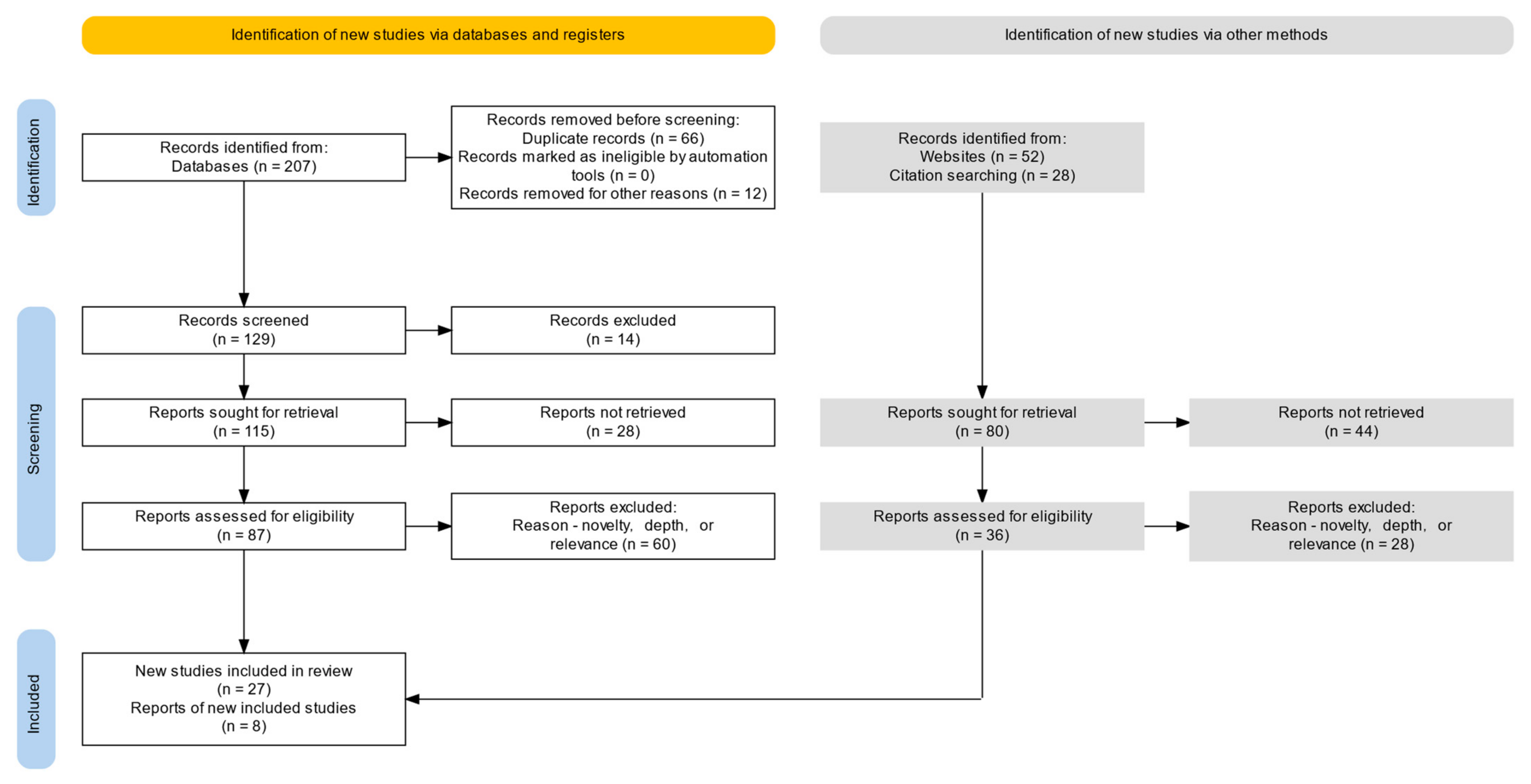
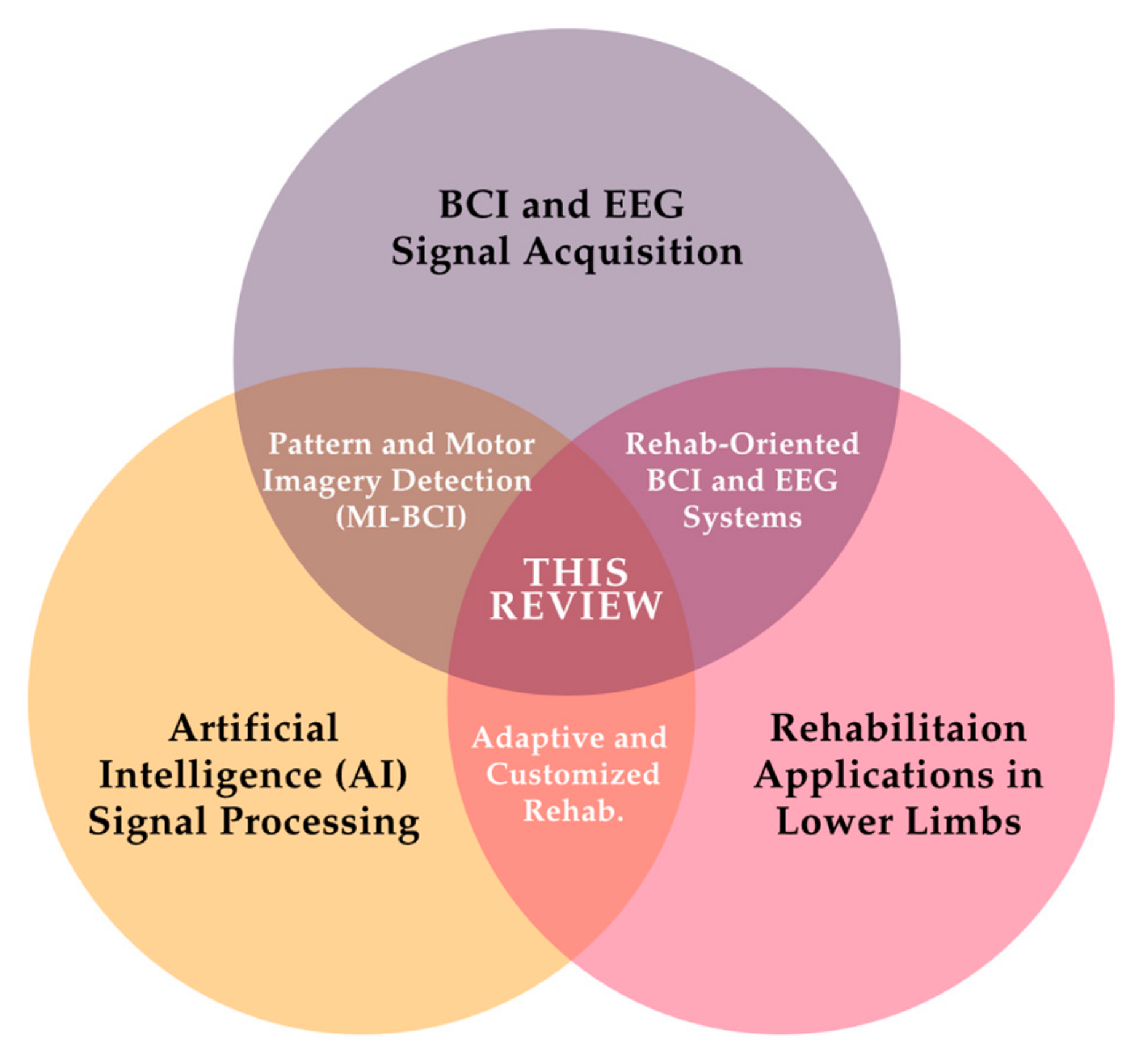
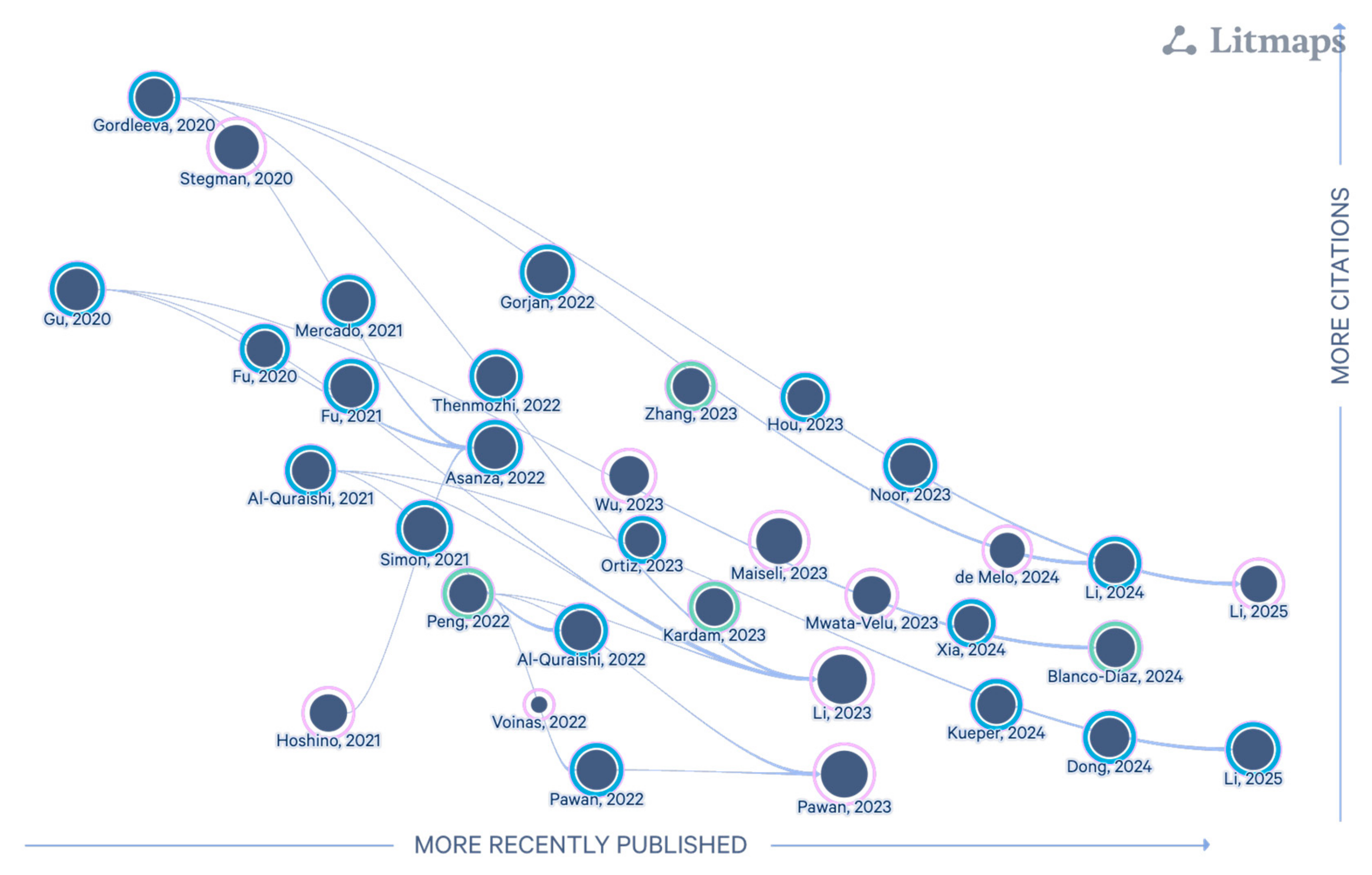

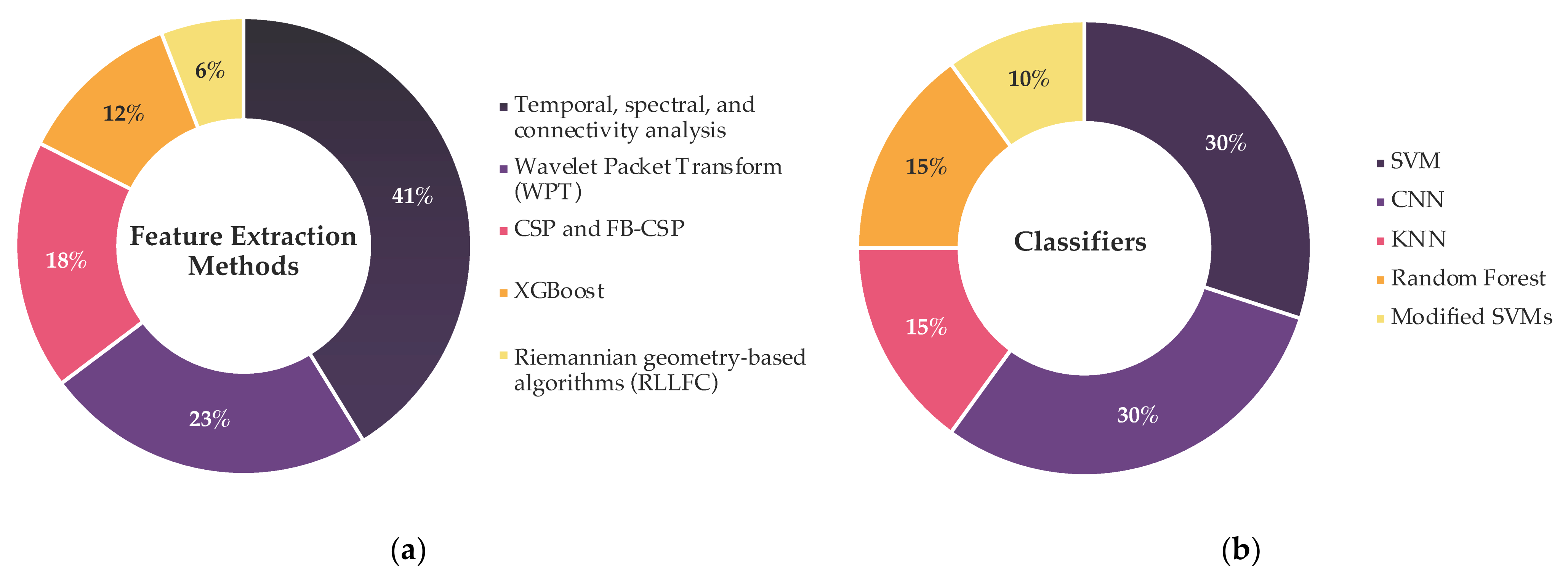
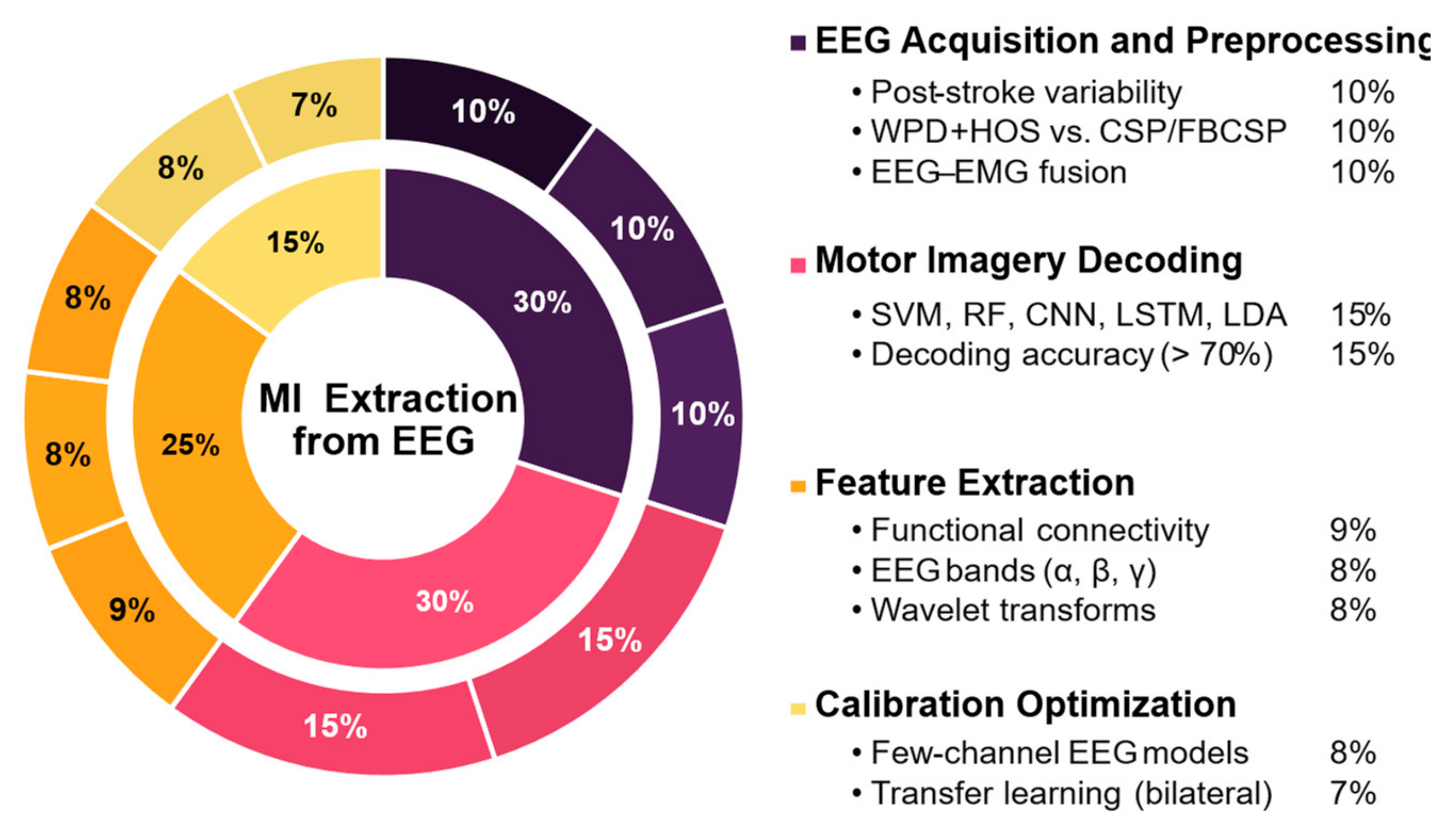

| Database | Search Query |
|---|---|
| Scopus | (TITLE-ABS-KEY ((“Electroencephalography” OR “EEG” OR “Brain”) AND (“signal” OR “Signal acquisition” OR “Data recording” OR “Processing” OR “Analysis”) AND (“Motor imagery” OR “Motor intention” OR “Movement imagination” OR “Mental rehearsal” OR “Motor tasks”) AND (“Artificial intelligence” OR “Machine learning” OR “Deep learning” OR “Pattern” OR “Classification” OR “Neural networks”) AND (“Brain-computer interface” OR “BCI” OR “Neural interface” OR “Brain-machine interface” OR “BMI” OR “Neuro*”) AND (“Lower limbs” OR “Legs” OR “Foot movements” OR “Gait analysis” OR “Walking” OR “lower”))) AND PUBYEAR > 2019 AND PUBYEAR < 2026 AND (LIMIT-TO (SUBJAREA, “COMP”) OR LIMIT-TO (SUBJAREA, “ENGI”)) AND (LIMIT-TO (DOCTYPE, “ar”) OR LIMIT-TO (DOCTYPE, “re”)) AND (LIMIT-TO (LANGUAGE, “English”)) |
| IEEE Xplore | ((“Electroencephalography” OR “EEG” OR “Brain”) AND (“Signal” OR “Signal acquisition” OR “Data recording” OR “Processing” OR “Analysis”) AND (“Motor imagery” OR “Motor intention” OR “Movement imagination” OR “Mental rehearsal” OR “Motor tasks”) AND (“Artificial intelligence” OR “Machine learning” OR “Deep learning” OR “Pattern recognition” OR “Classification” OR “Neural networks”) AND (“Brain-computer interface” OR “BCI” OR “Neural interface” OR “Brain-machine interface” OR “BMI” OR “Neuro*”) AND (“Lower limbs” OR “Legs” OR “Foot movements” OR “Gait analysis” OR “Walking” OR “Lower”)) Filters Applied: Conferences, Range 2020–2025 |
| Study | Year | Study Design | PCPs | Strategy | Main Contribution or Milestone | Sample Size | Classes | Feature Types | Used Techniques | Data Type |
|---|---|---|---|---|---|---|---|---|---|---|
| [16] | 2023 | REV | NP | Publication trend analysis by country/year since 2019 | Proposes a theoretical BCI architecture as a potential solution. | NA | NA | NA | NA | NA |
| [17] | 2024 | EXP + COMP | HS | Technical (non-medical) intervention | Average classification accuracy: 95% for MI. | 15 | 2 | NS | Multiple ML methods | RAW |
| [18] | 2022 | REV | NP | Document analysis of 22 relevant articles | Highlights the need for algorithm selection aligned with the goal and interpretability alongside accuracy. | NA | NA | NA | NA | NA |
| [19] | 2022 | REV | NP | Analytical and methodological intervention | Specific recommendations based on movement type/intensity. Compares methods’ pros and cons. | NA | NA | NA | NA | NA |
| [20] | 2023 | EXP + COMP | NP | EEMD + NN over existing EEG | Improved accuracy by 15% over EMD. | NS | 2 | EEMD | ANN (DL) | PPD |
| [21] | 2021 | EXP | HS | Multilayer perceptron (MLP) for torque decoding | More accurate for right leg. | NS | 2 | EEG | MLP (DL) | RAW |
| [22] | 2024 | EXP | HS | LSTM for lower-limb kinematics | Moderate accuracy for functional classification. | NS | 2 | EEG | LSTM (DL) | RAW |
| [23] | 2020 | EXP | HS | Multimodal and HMI exoskeleton control | Fusion improves accuracy and reliability. | NS | 2 | EEG + EMG | Multiple ML methods | RAW |
| [24] | 2021 | EXP | HS | Fusion via DCA classified by LDA | Improved accuracy from 89% to 97%. | 28 | 2 | EEG + EMG | DCA + LDA | PPD |
| [25] | 2023 | EXP + COMP | PS | Resting-state EEG (60s) | Accuracy: 87.50%. | NS | 2 | EEG signal time-series | LSTM (DL) | RAW |
| [26] | 2023 | EXP + COMP | HS | SVM optimized with particle swarm | Accuracy: 88.43%, improvement of 3.35–5.41%. | NS | 2 | TCS + PSO | SVM (ML) | PPD |
| [27] | 2023 | EXP + COMP | NP | WPD for features, SVM and KNN | Max acc: SVM 91.66%, KNN 90.33%. | NS | 2 | Wavelet features | SVM, KNN (ML) | PPD |
| [28] | 2020 | EXP + COMP | HS | PLV to create brain networks, SMLR + SVM | Accuracy up to 75%. | 11 | 2 | PLV (α and β bands) | SMLR + SVM (ML) | PPD |
| [29] | 2023 | EXP | HS | EEG recording during exoskeleton MI | Classification accuracy above 70%. | NS | 2 | EEG | Multiple ML methods | RAW |
| [30] | 2020 | EXP + COMP | NP | Sparse CSP + LDA | Accuracy improvement of 10.75%. | NS | 2 | CSP Features | LDA (ML) | PPD |
| [31] | 2023 | COMP | NP | Comparison of algorithms for BCI | Best accuracy: 89.7%. | NS | >2 | Mixed features | Multiple ML methods | PPD |
| [32] | 2021 | EXP + COMP | PS | SVM trained with spatial/network features | Best accuracy: 92.96%. | 30 | 2 | CSP Features | SVM (ML) | PPD |
| [33] | 2023 | COMP | HS | RWOS-ELM + SMOTE + ENN online learning | Error reduction and stabilization. | 6 | >2 | EEG signal time-series | RWOS-ELM (ML) | RAW |
| [34] | 2022 | EXP + COMP | HS | CWT for TF maps; ViT and ResNet | Best accuracy: 97.33%. | NS | 4 | CWT | ViT, ResNet (DL) | PPD |
| [35] | 2023 | COMP | NP | EEGNeX ConvNet vs. 16 DL models | Accuracy gains: 2.1–8.5%. | NS | 11 | ConvNet features | EEGNeX (DL) | PPD |
| [36] | 2023 | COMP | HS | CNN + spatial attention vs. EEG-Inception | Accuracy: 96.75%. | 52 | 2 | EEG maps | CNN (DL) | RAW |
| [37] | 2023 | COMP | HS | RLLFC + SVM | Accuracy: 88.4%. | 20 | 2 | Riemannian + Spatial | SVM (ML) | PPD |
| [38] | 2022 | COMP | NP | XGBO + Random Forest | Acc: 94.44% (IIIa), 88.72% (IVa). | NS | 2 | Mixed features | XGBoost + RF (ML) | PPD |
| [39] | 2025 | COMP | HS | CNN + Prob-Sparse Attention | Offline: >89%; online: 57.28%. | NS | 2 | Spatio-temporal | CNN + Attention (DL) | RAW |
| [40] | 2020 | REV | NP | Review of BCI system development trends | Guidelines for making BCI systems more accessible and collaborative. | NA | NA | NA | NA | NA |
| [41] | 2025 | EXP | HS + PS | EEG–EMG fusion, SVM voting | Fusion acc: 94.33% (HS), 87.54% (SCI). | 13 | 3 | EEG + EMG | SVM (ML) | PPD |
| [42] | 2024 | COMP | HS | Transfer learning for classifier | Best accuracy: 84.5%. | 8 | 2 | EEG | Transfer Learning (DL) | PPD |
| [43] | 2024 | EXP + COMP | HS | Cross-subject neural network pipeline | Identification rate: 83.6%. | 14 | 2 | NS | ANN (DL) | RAW |
| [44] | 2021 | REV | NP | Multimodal, multi-stage strategy with neuroimaging transitioning to mobile systems; protocol standardization | Proposes clinical adoption roadmap with multimodal methods and protocols. | NA | NA | NA | NA | NA |
| [45] | 2022 | EXP | PS | RF with WPD + HOS | Accuracy > 70%. | 6 | 2 | WPD + HOS | Random Forest (ML) | PPD |
| [46] | 2023 | EXP + COMP | HS | Multiple classifiers | Acc. Binary: 93%; Multiclass: 70%; Cross-subject: 61%. | 1 | 4 | CSP, DWT, TF | ML/DL mixed | PPD |
| [47] | 2023 | REV | NP | Feature extraction and classifiers benchmarking | ML performs well with few channels; DL improves accuracy but needs more data/computation time. | NA | NA | NA | WT, WPT, SVM, LDA, RF, KNN, CNN | NA |
| [48] | 2021 | EXP | PS | Multiple regression on FC | Early FC predicts LL recovery. | 24 | NS | NS | Linear regression | RAW |
| [49] | 2023 | EXP + COMP | HS | MRCP and ERD in VR | VR improved peak amplitude, SNR. | 12 | 2 | MRCP, ERD | ANN (DL) | RAW |
| [50] | 2023 | REV | NP | Multisensor: EEG, EMG. Biomechanics. | Highlights preprocessing and benchmarking needs. | NA | NA | NA | SVM, RF, KNN, LD (ML), ANN (DL) | NA |
Disclaimer/Publisher’s Note: The statements, opinions and data contained in all publications are solely those of the individual author(s) and contributor(s) and not of MDPI and/or the editor(s). MDPI and/or the editor(s) disclaim responsibility for any injury to people or property resulting from any ideas, methods, instructions or products referred to in the content. |
© 2025 by the authors. Licensee MDPI, Basel, Switzerland. This article is an open access article distributed under the terms and conditions of the Creative Commons Attribution (CC BY) license (https://creativecommons.org/licenses/by/4.0/).
Share and Cite
Moreno-Castelblanco, S.R.; Vélez-Guerrero, M.A.; Callejas-Cuervo, M. Artificial Intelligence Approaches for EEG Signal Acquisition and Processing in Lower-Limb Motor Imagery: A Systematic Review. Sensors 2025, 25, 5030. https://doi.org/10.3390/s25165030
Moreno-Castelblanco SR, Vélez-Guerrero MA, Callejas-Cuervo M. Artificial Intelligence Approaches for EEG Signal Acquisition and Processing in Lower-Limb Motor Imagery: A Systematic Review. Sensors. 2025; 25(16):5030. https://doi.org/10.3390/s25165030
Chicago/Turabian StyleMoreno-Castelblanco, Sonia Rocío, Manuel Andrés Vélez-Guerrero, and Mauro Callejas-Cuervo. 2025. "Artificial Intelligence Approaches for EEG Signal Acquisition and Processing in Lower-Limb Motor Imagery: A Systematic Review" Sensors 25, no. 16: 5030. https://doi.org/10.3390/s25165030
APA StyleMoreno-Castelblanco, S. R., Vélez-Guerrero, M. A., & Callejas-Cuervo, M. (2025). Artificial Intelligence Approaches for EEG Signal Acquisition and Processing in Lower-Limb Motor Imagery: A Systematic Review. Sensors, 25(16), 5030. https://doi.org/10.3390/s25165030








